BED205: Strategies for Supporting Learners with PMLD Assignment
VerifiedAdded on 2021/11/16
|14
|3010
|367
Report
AI Summary
This report, submitted by Sephora Ellul for the BED205 module, focuses on strategies for supporting learners with Profound and Multiple Learning Disabilities (PMLD). The assignment addresses key concepts such as profound intellectual impairment, sensory-based interventions, and the importance of observation in understanding a child's needs. It explores the application of sensory stories as a teaching method, emphasizing their role in engaging students with PMLD. The report also examines essential skills for educators, including patience, communication, and creativity, alongside the benefits of inclusive education and collaboration between teachers and parents. The analysis incorporates theories from Piaget, Vygotsky, and Bandura to provide a comprehensive understanding of effective support strategies. The report emphasizes the need for tailored approaches, considering physical and intellectual impairments, and the significance of consistent support across different educational settings like mainstream schools and resource centers. The importance of collaboration between educators, parents, and the student themselves is highlighted to create a supportive and effective learning environment.
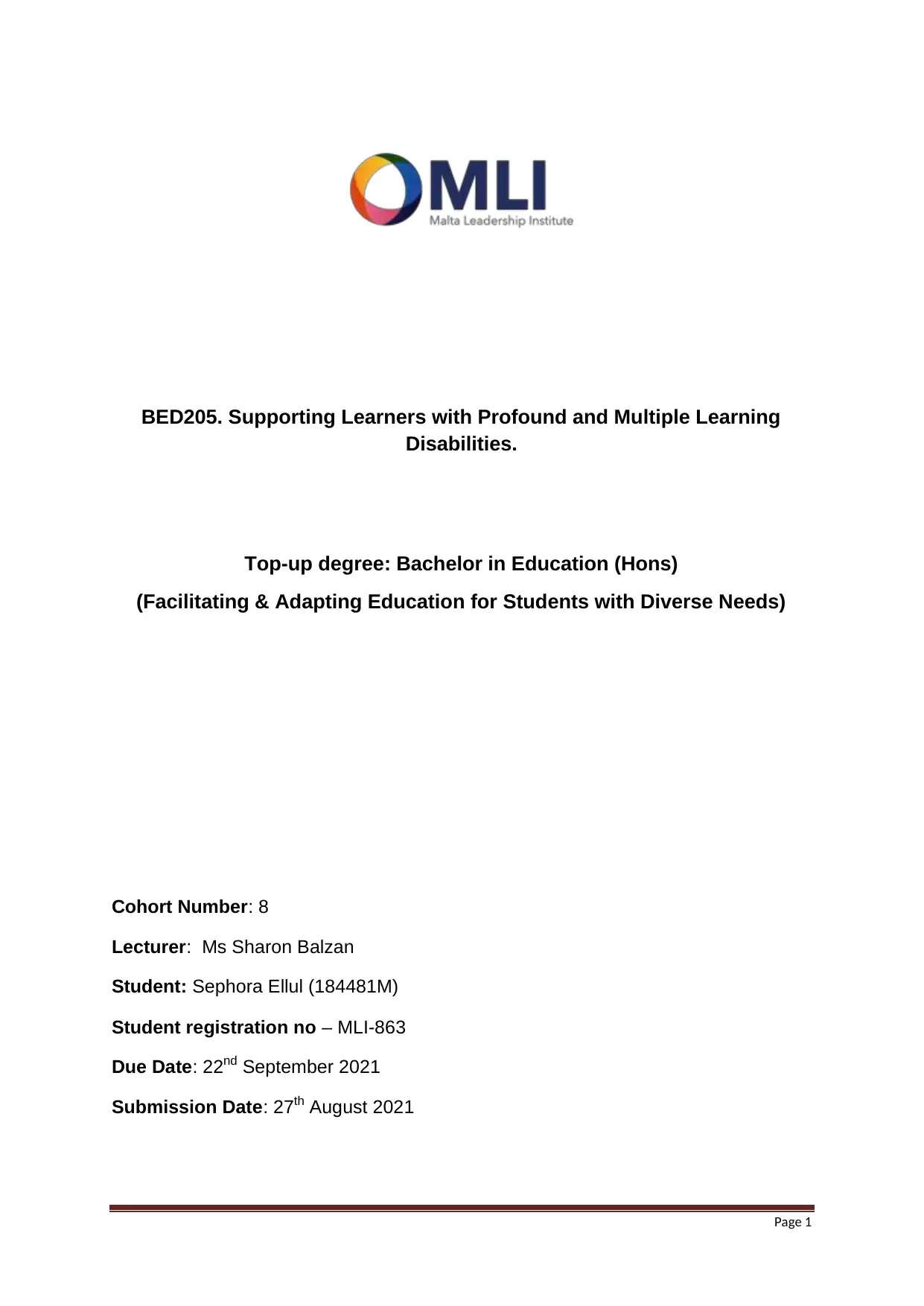
Page 1
BED205. Supporting Learners with Profound and Multiple Learning
Disabilities.
Top-up degree: Bachelor in Education (Hons)
(Facilitating & Adapting Education for Students with Diverse Needs)
Cohort Number: 8
Lecturer: Ms Sharon Balzan
Student: Sephora Ellul (184481M)
Student registration no – MLI-863
Due Date: 22nd September 2021
Submission Date: 27th August 2021
BED205. Supporting Learners with Profound and Multiple Learning
Disabilities.
Top-up degree: Bachelor in Education (Hons)
(Facilitating & Adapting Education for Students with Diverse Needs)
Cohort Number: 8
Lecturer: Ms Sharon Balzan
Student: Sephora Ellul (184481M)
Student registration no – MLI-863
Due Date: 22nd September 2021
Submission Date: 27th August 2021
Paraphrase This Document
Need a fresh take? Get an instant paraphrase of this document with our AI Paraphraser
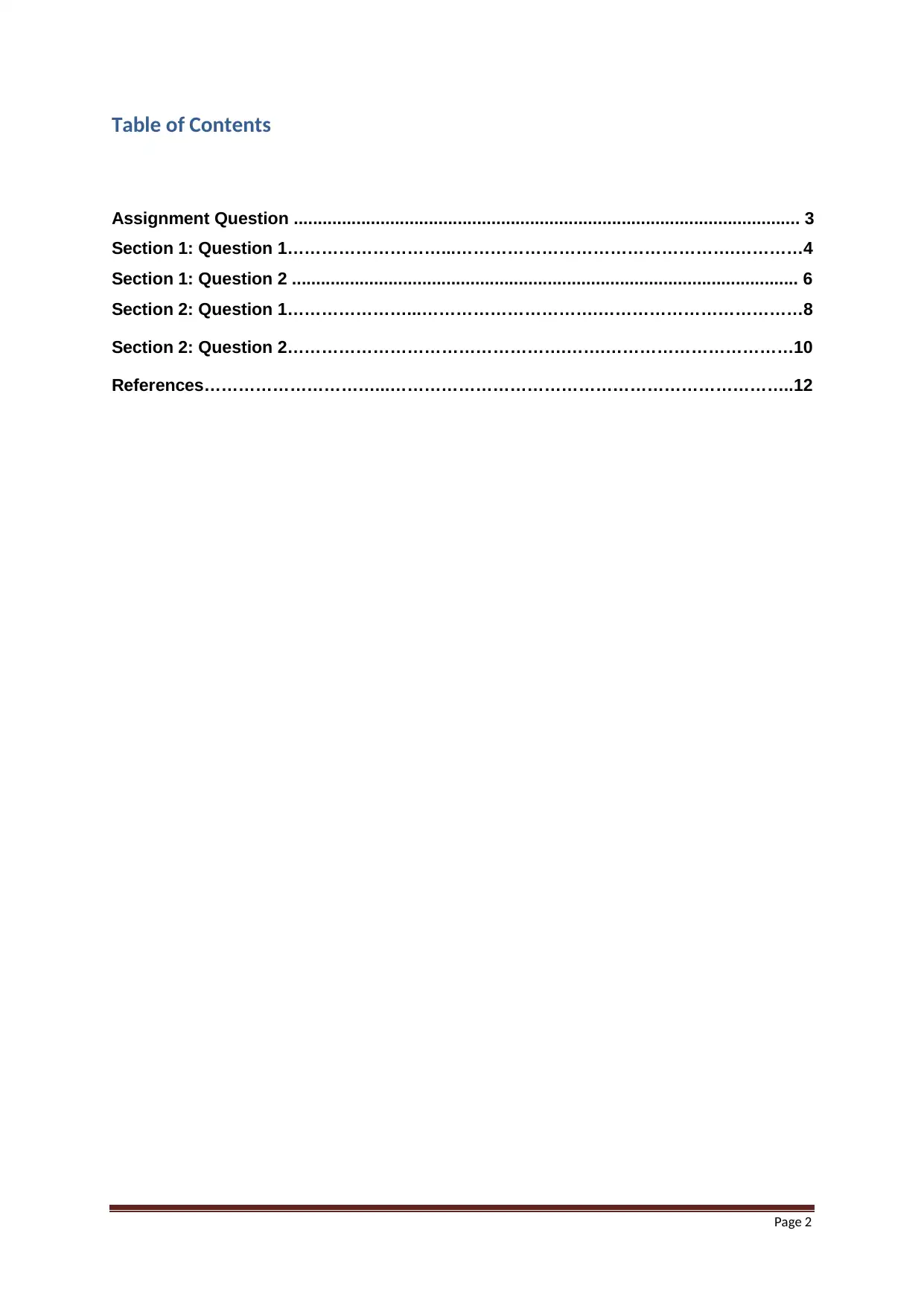
Page 2
Table of Contents
Assignment Question ......................................................................................................... 3
Section 1: Question 1………………………...………………………………………….…………4
Section 1: Question 2 ......................................................................................................... 6
Section 2: Question 1…………………...………………………….………………………………8
Section 2: Question 2………………………………………….…….……………………………10
References…………………………...……………………………………………………………..12
Table of Contents
Assignment Question ......................................................................................................... 3
Section 1: Question 1………………………...………………………………………….…………4
Section 1: Question 2 ......................................................................................................... 6
Section 2: Question 1…………………...………………………….………………………………8
Section 2: Question 2………………………………………….…….……………………………10
References…………………………...……………………………………………………………..12
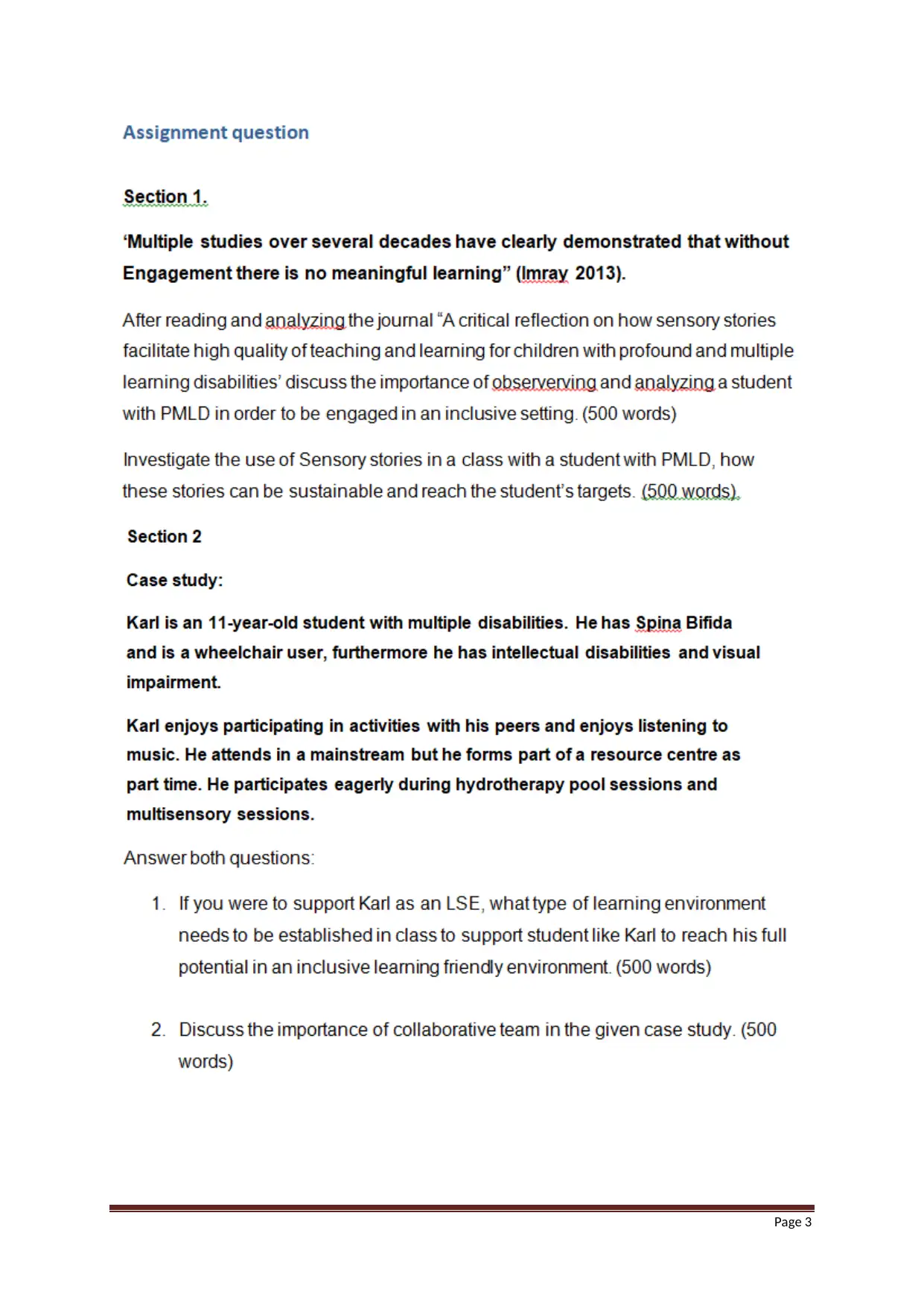
Page 3
⊘ This is a preview!⊘
Do you want full access?
Subscribe today to unlock all pages.

Trusted by 1+ million students worldwide
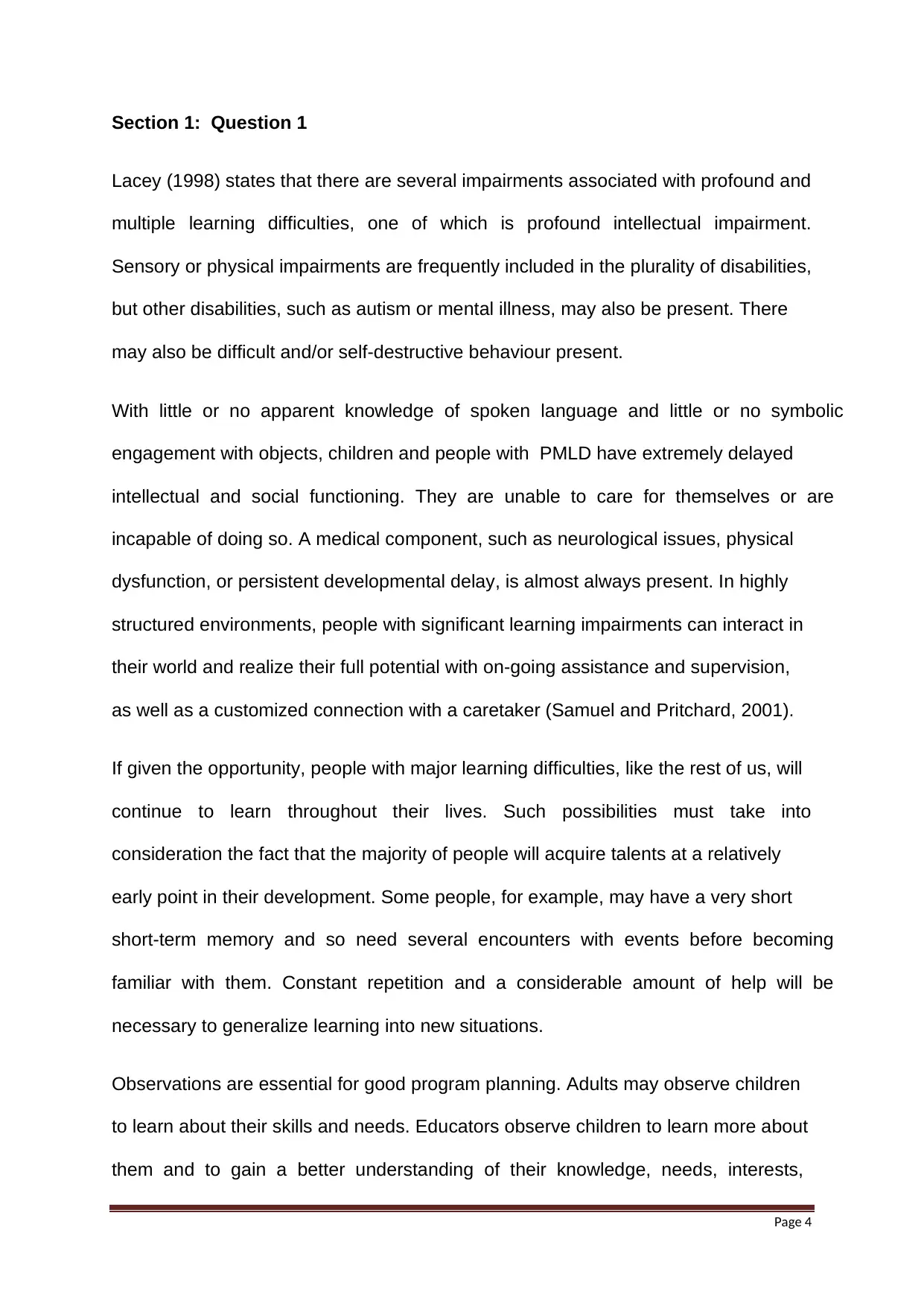
Page 4
Section 1: Question 1
Lacey (1998) states that there are several impairments associated with profound and
multiple learning difficulties, one of which is profound intellectual impairment.
Sensory or physical impairments are frequently included in the plurality of disabilities,
but other disabilities, such as autism or mental illness, may also be present. There
may also be difficult and/or self-destructive behaviour present.
With little or no apparent knowledge of spoken language and little or no symbolic
engagement with objects, children and people with PMLD have extremely delayed
intellectual and social functioning. They are unable to care for themselves or are
incapable of doing so. A medical component, such as neurological issues, physical
dysfunction, or persistent developmental delay, is almost always present. In highly
structured environments, people with significant learning impairments can interact in
their world and realize their full potential with on-going assistance and supervision,
as well as a customized connection with a caretaker (Samuel and Pritchard, 2001).
If given the opportunity, people with major learning difficulties, like the rest of us, will
continue to learn throughout their lives. Such possibilities must take into
consideration the fact that the majority of people will acquire talents at a relatively
early point in their development. Some people, for example, may have a very short
short-term memory and so need several encounters with events before becoming
familiar with them. Constant repetition and a considerable amount of help will be
necessary to generalize learning into new situations.
Observations are essential for good program planning. Adults may observe children
to learn about their skills and needs. Educators observe children to learn more about
them and to gain a better understanding of their knowledge, needs, interests,
Section 1: Question 1
Lacey (1998) states that there are several impairments associated with profound and
multiple learning difficulties, one of which is profound intellectual impairment.
Sensory or physical impairments are frequently included in the plurality of disabilities,
but other disabilities, such as autism or mental illness, may also be present. There
may also be difficult and/or self-destructive behaviour present.
With little or no apparent knowledge of spoken language and little or no symbolic
engagement with objects, children and people with PMLD have extremely delayed
intellectual and social functioning. They are unable to care for themselves or are
incapable of doing so. A medical component, such as neurological issues, physical
dysfunction, or persistent developmental delay, is almost always present. In highly
structured environments, people with significant learning impairments can interact in
their world and realize their full potential with on-going assistance and supervision,
as well as a customized connection with a caretaker (Samuel and Pritchard, 2001).
If given the opportunity, people with major learning difficulties, like the rest of us, will
continue to learn throughout their lives. Such possibilities must take into
consideration the fact that the majority of people will acquire talents at a relatively
early point in their development. Some people, for example, may have a very short
short-term memory and so need several encounters with events before becoming
familiar with them. Constant repetition and a considerable amount of help will be
necessary to generalize learning into new situations.
Observations are essential for good program planning. Adults may observe children
to learn about their skills and needs. Educators observe children to learn more about
them and to gain a better understanding of their knowledge, needs, interests,
Paraphrase This Document
Need a fresh take? Get an instant paraphrase of this document with our AI Paraphraser
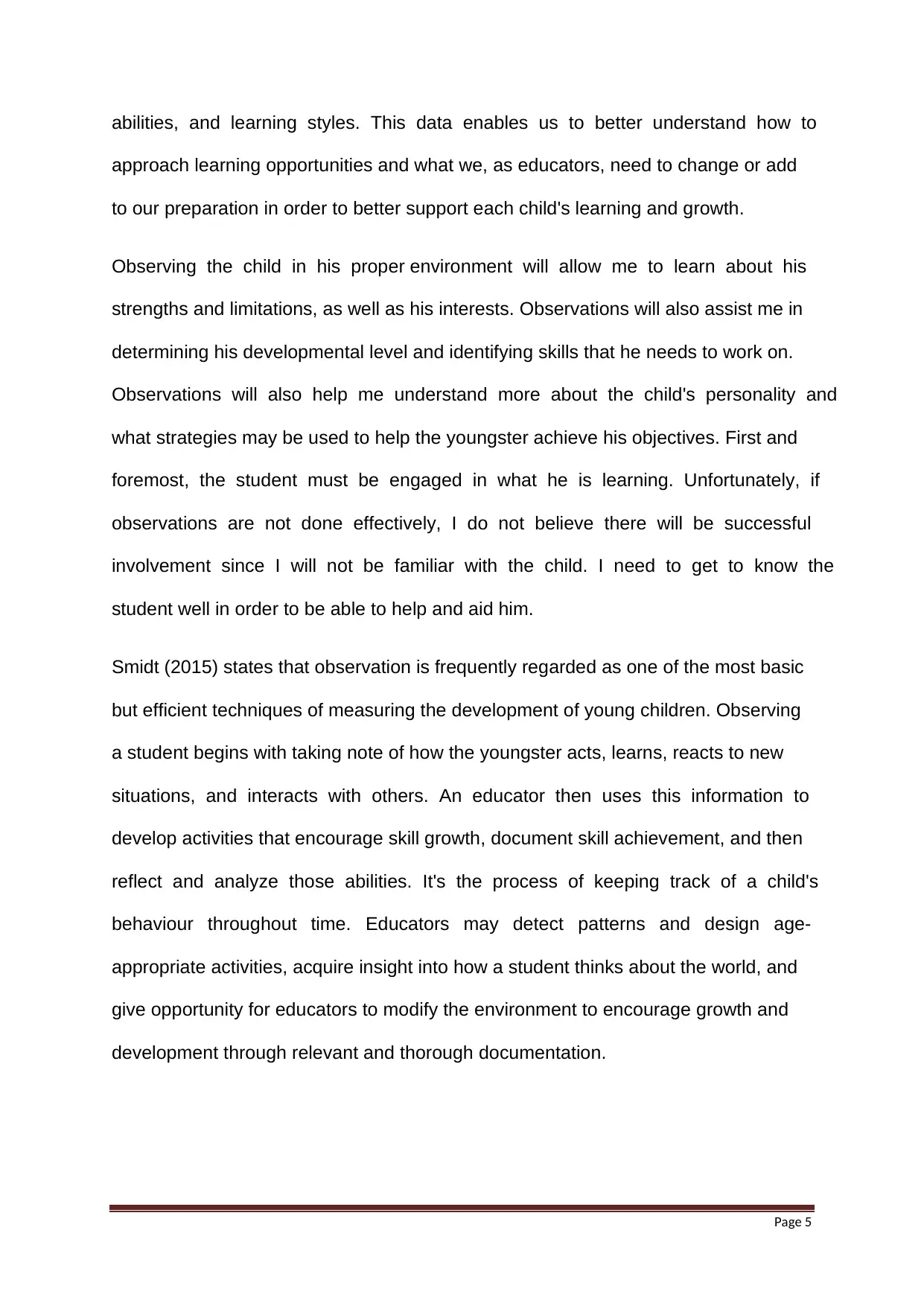
Page 5
abilities, and learning styles. This data enables us to better understand how to
approach learning opportunities and what we, as educators, need to change or add
to our preparation in order to better support each child's learning and growth.
Observing the child in his proper environment will allow me to learn about his
strengths and limitations, as well as his interests. Observations will also assist me in
determining his developmental level and identifying skills that he needs to work on.
Observations will also help me understand more about the child's personality and
what strategies may be used to help the youngster achieve his objectives. First and
foremost, the student must be engaged in what he is learning. Unfortunately, if
observations are not done effectively, I do not believe there will be successful
involvement since I will not be familiar with the child. I need to get to know the
student well in order to be able to help and aid him.
Smidt (2015) states that observation is frequently regarded as one of the most basic
but efficient techniques of measuring the development of young children. Observing
a student begins with taking note of how the youngster acts, learns, reacts to new
situations, and interacts with others. An educator then uses this information to
develop activities that encourage skill growth, document skill achievement, and then
reflect and analyze those abilities. It's the process of keeping track of a child's
behaviour throughout time. Educators may detect patterns and design age-
appropriate activities, acquire insight into how a student thinks about the world, and
give opportunity for educators to modify the environment to encourage growth and
development through relevant and thorough documentation.
abilities, and learning styles. This data enables us to better understand how to
approach learning opportunities and what we, as educators, need to change or add
to our preparation in order to better support each child's learning and growth.
Observing the child in his proper environment will allow me to learn about his
strengths and limitations, as well as his interests. Observations will also assist me in
determining his developmental level and identifying skills that he needs to work on.
Observations will also help me understand more about the child's personality and
what strategies may be used to help the youngster achieve his objectives. First and
foremost, the student must be engaged in what he is learning. Unfortunately, if
observations are not done effectively, I do not believe there will be successful
involvement since I will not be familiar with the child. I need to get to know the
student well in order to be able to help and aid him.
Smidt (2015) states that observation is frequently regarded as one of the most basic
but efficient techniques of measuring the development of young children. Observing
a student begins with taking note of how the youngster acts, learns, reacts to new
situations, and interacts with others. An educator then uses this information to
develop activities that encourage skill growth, document skill achievement, and then
reflect and analyze those abilities. It's the process of keeping track of a child's
behaviour throughout time. Educators may detect patterns and design age-
appropriate activities, acquire insight into how a student thinks about the world, and
give opportunity for educators to modify the environment to encourage growth and
development through relevant and thorough documentation.
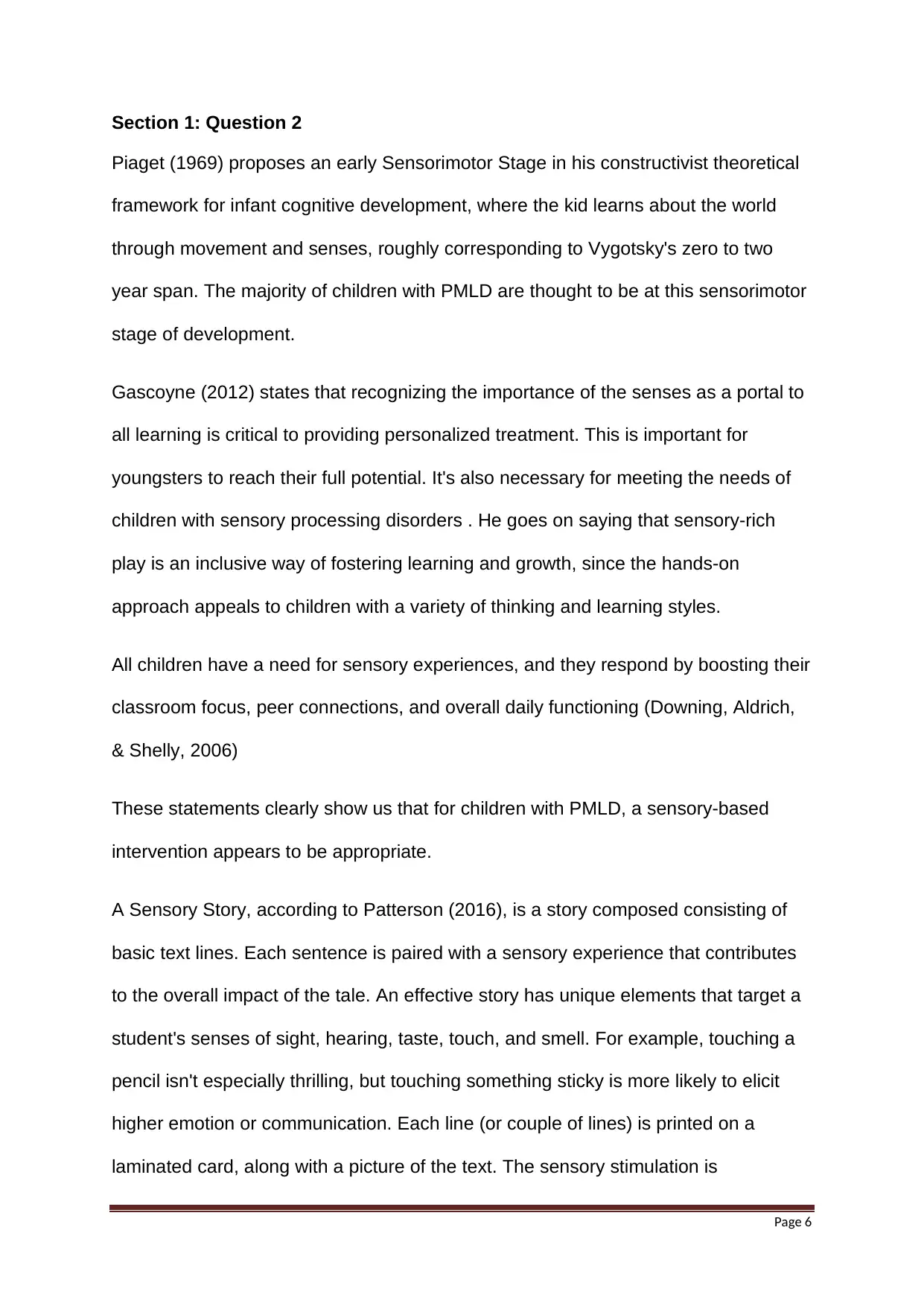
Page 6
Section 1: Question 2
Piaget (1969) proposes an early Sensorimotor Stage in his constructivist theoretical
framework for infant cognitive development, where the kid learns about the world
through movement and senses, roughly corresponding to Vygotsky's zero to two
year span. The majority of children with PMLD are thought to be at this sensorimotor
stage of development.
Gascoyne (2012) states that recognizing the importance of the senses as a portal to
all learning is critical to providing personalized treatment. This is important for
youngsters to reach their full potential. It's also necessary for meeting the needs of
children with sensory processing disorders . He goes on saying that sensory-rich
play is an inclusive way of fostering learning and growth, since the hands-on
approach appeals to children with a variety of thinking and learning styles.
All children have a need for sensory experiences, and they respond by boosting their
classroom focus, peer connections, and overall daily functioning (Downing, Aldrich,
& Shelly, 2006)
These statements clearly show us that for children with PMLD, a sensory-based
intervention appears to be appropriate.
A Sensory Story, according to Patterson (2016), is a story composed consisting of
basic text lines. Each sentence is paired with a sensory experience that contributes
to the overall impact of the tale. An effective story has unique elements that target a
student's senses of sight, hearing, taste, touch, and smell. For example, touching a
pencil isn't especially thrilling, but touching something sticky is more likely to elicit
higher emotion or communication. Each line (or couple of lines) is printed on a
laminated card, along with a picture of the text. The sensory stimulation is
Section 1: Question 2
Piaget (1969) proposes an early Sensorimotor Stage in his constructivist theoretical
framework for infant cognitive development, where the kid learns about the world
through movement and senses, roughly corresponding to Vygotsky's zero to two
year span. The majority of children with PMLD are thought to be at this sensorimotor
stage of development.
Gascoyne (2012) states that recognizing the importance of the senses as a portal to
all learning is critical to providing personalized treatment. This is important for
youngsters to reach their full potential. It's also necessary for meeting the needs of
children with sensory processing disorders . He goes on saying that sensory-rich
play is an inclusive way of fostering learning and growth, since the hands-on
approach appeals to children with a variety of thinking and learning styles.
All children have a need for sensory experiences, and they respond by boosting their
classroom focus, peer connections, and overall daily functioning (Downing, Aldrich,
& Shelly, 2006)
These statements clearly show us that for children with PMLD, a sensory-based
intervention appears to be appropriate.
A Sensory Story, according to Patterson (2016), is a story composed consisting of
basic text lines. Each sentence is paired with a sensory experience that contributes
to the overall impact of the tale. An effective story has unique elements that target a
student's senses of sight, hearing, taste, touch, and smell. For example, touching a
pencil isn't especially thrilling, but touching something sticky is more likely to elicit
higher emotion or communication. Each line (or couple of lines) is printed on a
laminated card, along with a picture of the text. The sensory stimulation is
⊘ This is a preview!⊘
Do you want full access?
Subscribe today to unlock all pages.

Trusted by 1+ million students worldwide
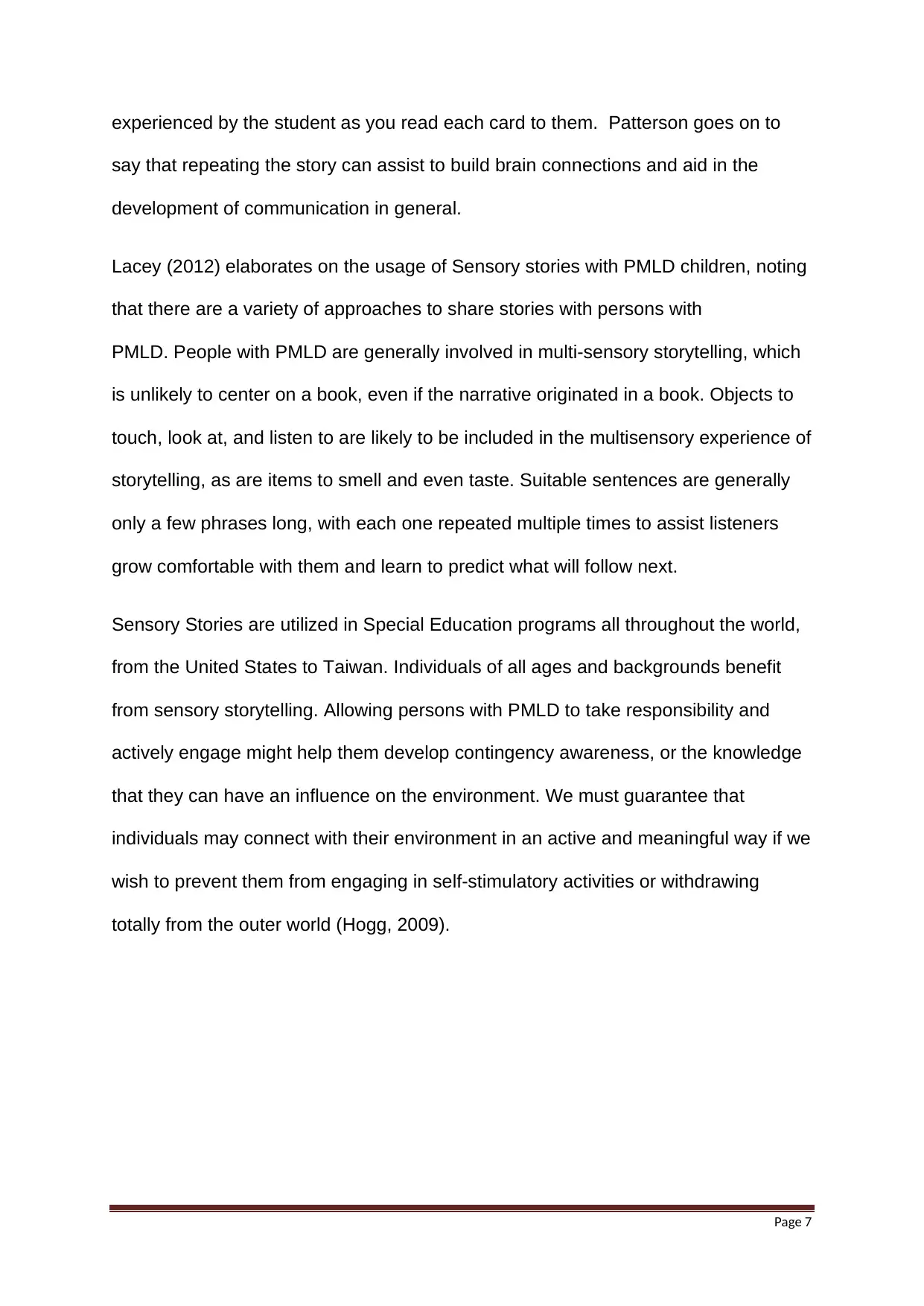
Page 7
experienced by the student as you read each card to them. Patterson goes on to
say that repeating the story can assist to build brain connections and aid in the
development of communication in general.
Lacey (2012) elaborates on the usage of Sensory stories with PMLD children, noting
that there are a variety of approaches to share stories with persons with
PMLD. People with PMLD are generally involved in multi-sensory storytelling, which
is unlikely to center on a book, even if the narrative originated in a book. Objects to
touch, look at, and listen to are likely to be included in the multisensory experience of
storytelling, as are items to smell and even taste. Suitable sentences are generally
only a few phrases long, with each one repeated multiple times to assist listeners
grow comfortable with them and learn to predict what will follow next.
Sensory Stories are utilized in Special Education programs all throughout the world,
from the United States to Taiwan. Individuals of all ages and backgrounds benefit
from sensory storytelling. Allowing persons with PMLD to take responsibility and
actively engage might help them develop contingency awareness, or the knowledge
that they can have an influence on the environment. We must guarantee that
individuals may connect with their environment in an active and meaningful way if we
wish to prevent them from engaging in self-stimulatory activities or withdrawing
totally from the outer world (Hogg, 2009).
experienced by the student as you read each card to them. Patterson goes on to
say that repeating the story can assist to build brain connections and aid in the
development of communication in general.
Lacey (2012) elaborates on the usage of Sensory stories with PMLD children, noting
that there are a variety of approaches to share stories with persons with
PMLD. People with PMLD are generally involved in multi-sensory storytelling, which
is unlikely to center on a book, even if the narrative originated in a book. Objects to
touch, look at, and listen to are likely to be included in the multisensory experience of
storytelling, as are items to smell and even taste. Suitable sentences are generally
only a few phrases long, with each one repeated multiple times to assist listeners
grow comfortable with them and learn to predict what will follow next.
Sensory Stories are utilized in Special Education programs all throughout the world,
from the United States to Taiwan. Individuals of all ages and backgrounds benefit
from sensory storytelling. Allowing persons with PMLD to take responsibility and
actively engage might help them develop contingency awareness, or the knowledge
that they can have an influence on the environment. We must guarantee that
individuals may connect with their environment in an active and meaningful way if we
wish to prevent them from engaging in self-stimulatory activities or withdrawing
totally from the outer world (Hogg, 2009).
Paraphrase This Document
Need a fresh take? Get an instant paraphrase of this document with our AI Paraphraser
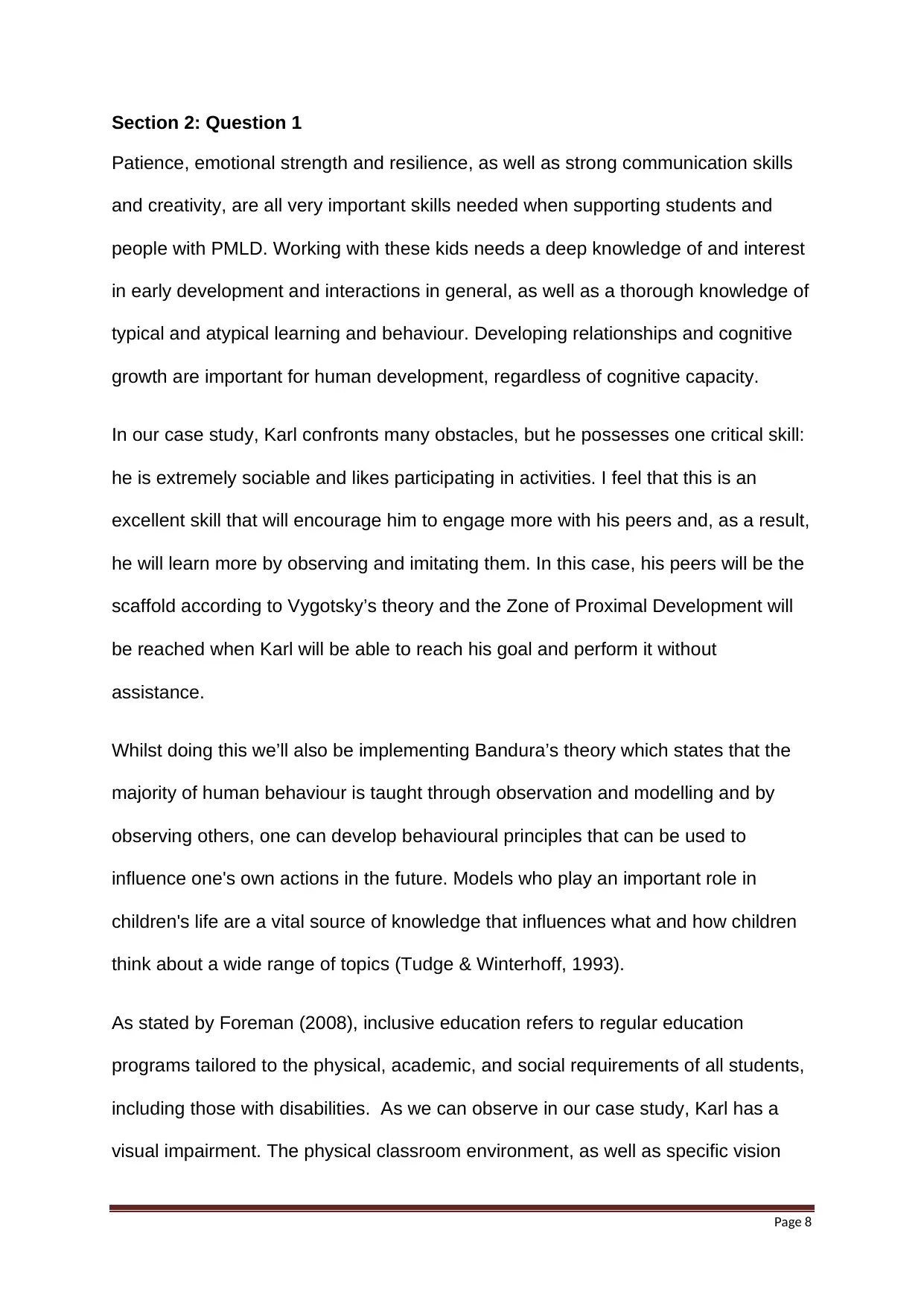
Page 8
Section 2: Question 1
Patience, emotional strength and resilience, as well as strong communication skills
and creativity, are all very important skills needed when supporting students and
people with PMLD. Working with these kids needs a deep knowledge of and interest
in early development and interactions in general, as well as a thorough knowledge of
typical and atypical learning and behaviour. Developing relationships and cognitive
growth are important for human development, regardless of cognitive capacity.
In our case study, Karl confronts many obstacles, but he possesses one critical skill:
he is extremely sociable and likes participating in activities. I feel that this is an
excellent skill that will encourage him to engage more with his peers and, as a result,
he will learn more by observing and imitating them. In this case, his peers will be the
scaffold according to Vygotsky’s theory and the Zone of Proximal Development will
be reached when Karl will be able to reach his goal and perform it without
assistance.
Whilst doing this we’ll also be implementing Bandura’s theory which states that the
majority of human behaviour is taught through observation and modelling and by
observing others, one can develop behavioural principles that can be used to
influence one's own actions in the future. Models who play an important role in
children's life are a vital source of knowledge that influences what and how children
think about a wide range of topics (Tudge & Winterhoff, 1993).
As stated by Foreman (2008), inclusive education refers to regular education
programs tailored to the physical, academic, and social requirements of all students,
including those with disabilities. As we can observe in our case study, Karl has a
visual impairment. The physical classroom environment, as well as specific vision
Section 2: Question 1
Patience, emotional strength and resilience, as well as strong communication skills
and creativity, are all very important skills needed when supporting students and
people with PMLD. Working with these kids needs a deep knowledge of and interest
in early development and interactions in general, as well as a thorough knowledge of
typical and atypical learning and behaviour. Developing relationships and cognitive
growth are important for human development, regardless of cognitive capacity.
In our case study, Karl confronts many obstacles, but he possesses one critical skill:
he is extremely sociable and likes participating in activities. I feel that this is an
excellent skill that will encourage him to engage more with his peers and, as a result,
he will learn more by observing and imitating them. In this case, his peers will be the
scaffold according to Vygotsky’s theory and the Zone of Proximal Development will
be reached when Karl will be able to reach his goal and perform it without
assistance.
Whilst doing this we’ll also be implementing Bandura’s theory which states that the
majority of human behaviour is taught through observation and modelling and by
observing others, one can develop behavioural principles that can be used to
influence one's own actions in the future. Models who play an important role in
children's life are a vital source of knowledge that influences what and how children
think about a wide range of topics (Tudge & Winterhoff, 1993).
As stated by Foreman (2008), inclusive education refers to regular education
programs tailored to the physical, academic, and social requirements of all students,
including those with disabilities. As we can observe in our case study, Karl has a
visual impairment. The physical classroom environment, as well as specific vision
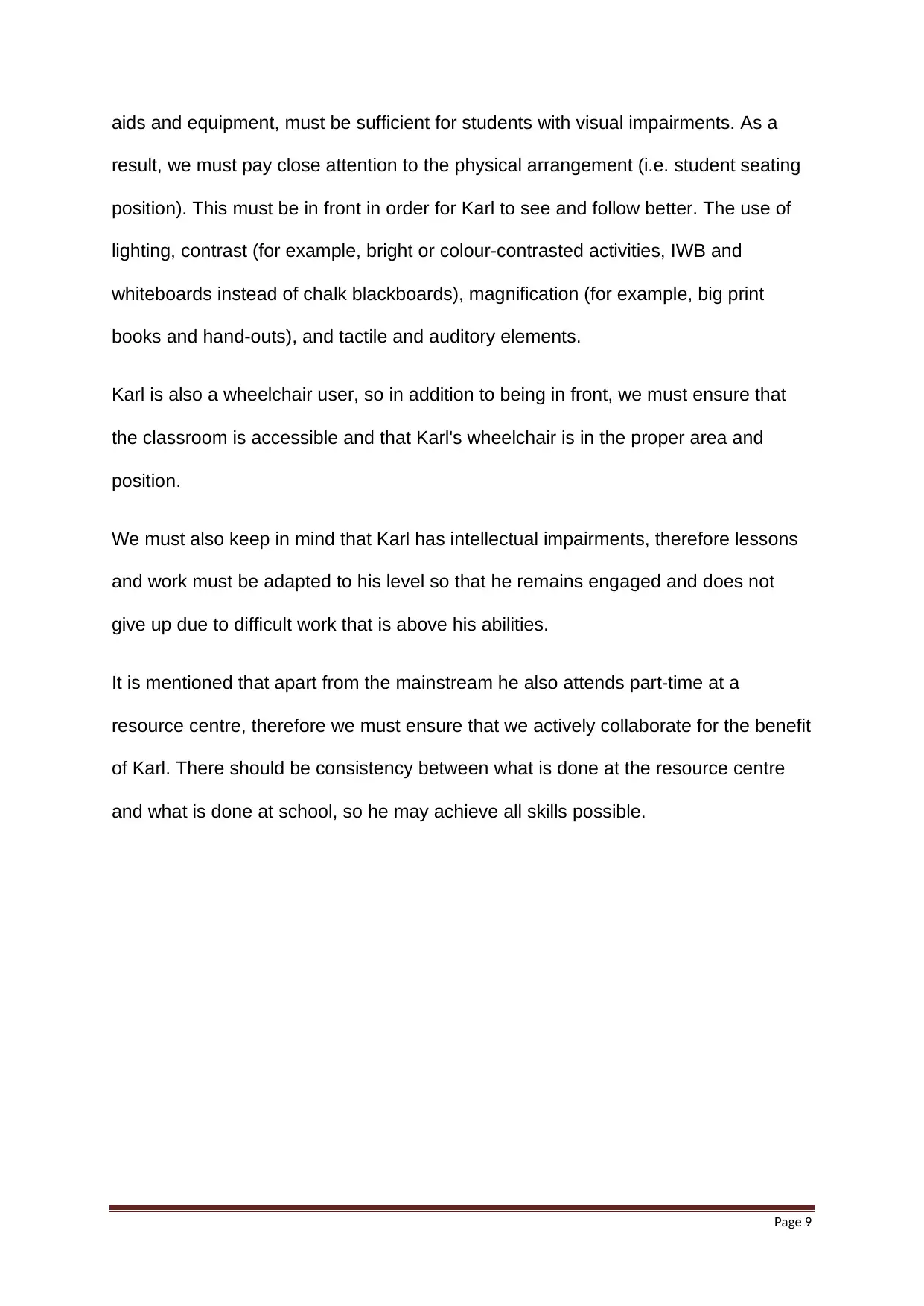
Page 9
aids and equipment, must be sufficient for students with visual impairments. As a
result, we must pay close attention to the physical arrangement (i.e. student seating
position). This must be in front in order for Karl to see and follow better. The use of
lighting, contrast (for example, bright or colour-contrasted activities, IWB and
whiteboards instead of chalk blackboards), magnification (for example, big print
books and hand-outs), and tactile and auditory elements.
Karl is also a wheelchair user, so in addition to being in front, we must ensure that
the classroom is accessible and that Karl's wheelchair is in the proper area and
position.
We must also keep in mind that Karl has intellectual impairments, therefore lessons
and work must be adapted to his level so that he remains engaged and does not
give up due to difficult work that is above his abilities.
It is mentioned that apart from the mainstream he also attends part-time at a
resource centre, therefore we must ensure that we actively collaborate for the benefit
of Karl. There should be consistency between what is done at the resource centre
and what is done at school, so he may achieve all skills possible.
aids and equipment, must be sufficient for students with visual impairments. As a
result, we must pay close attention to the physical arrangement (i.e. student seating
position). This must be in front in order for Karl to see and follow better. The use of
lighting, contrast (for example, bright or colour-contrasted activities, IWB and
whiteboards instead of chalk blackboards), magnification (for example, big print
books and hand-outs), and tactile and auditory elements.
Karl is also a wheelchair user, so in addition to being in front, we must ensure that
the classroom is accessible and that Karl's wheelchair is in the proper area and
position.
We must also keep in mind that Karl has intellectual impairments, therefore lessons
and work must be adapted to his level so that he remains engaged and does not
give up due to difficult work that is above his abilities.
It is mentioned that apart from the mainstream he also attends part-time at a
resource centre, therefore we must ensure that we actively collaborate for the benefit
of Karl. There should be consistency between what is done at the resource centre
and what is done at school, so he may achieve all skills possible.
⊘ This is a preview!⊘
Do you want full access?
Subscribe today to unlock all pages.

Trusted by 1+ million students worldwide
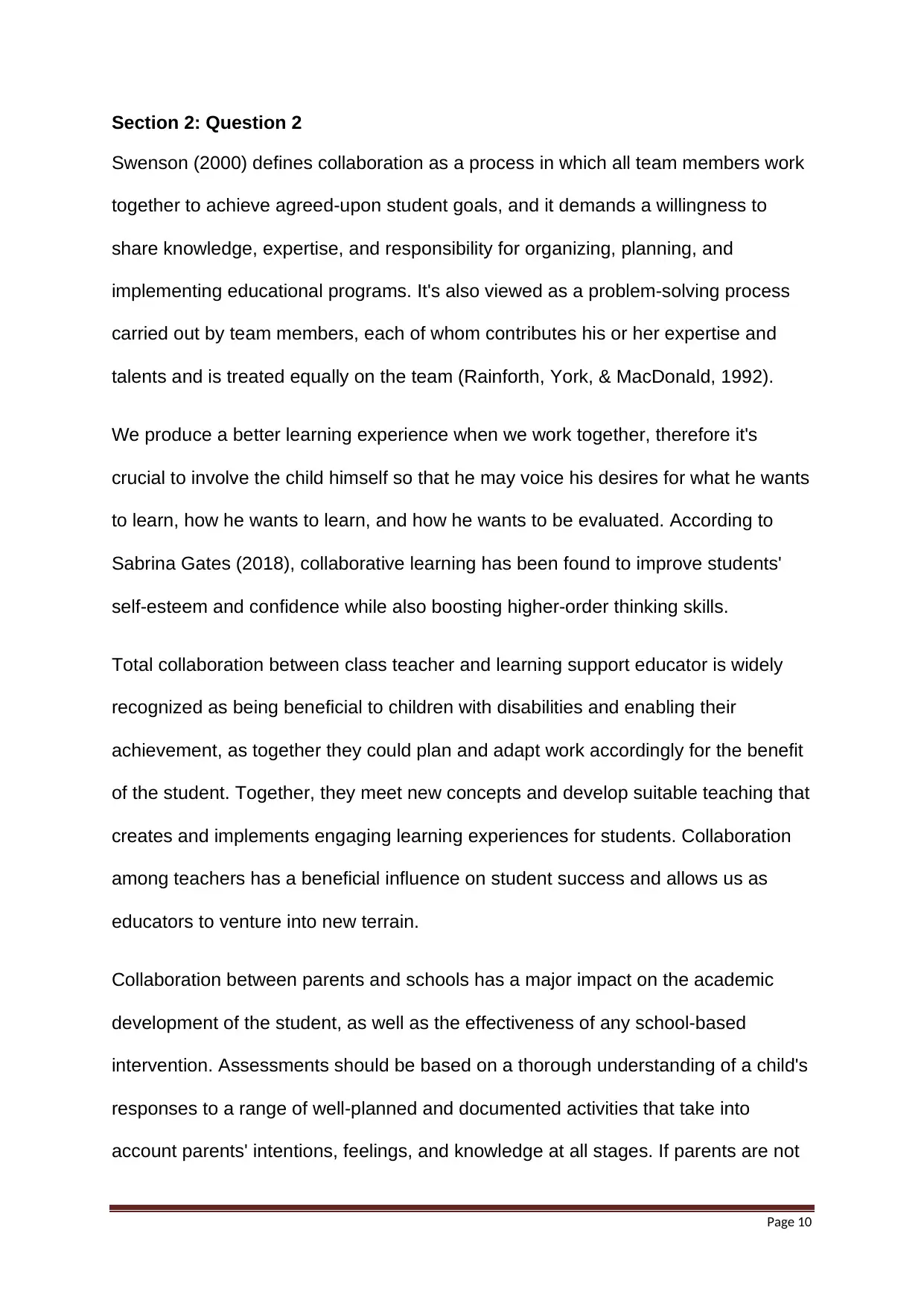
Page 10
Section 2: Question 2
Swenson (2000) defines collaboration as a process in which all team members work
together to achieve agreed-upon student goals, and it demands a willingness to
share knowledge, expertise, and responsibility for organizing, planning, and
implementing educational programs. It's also viewed as a problem-solving process
carried out by team members, each of whom contributes his or her expertise and
talents and is treated equally on the team (Rainforth, York, & MacDonald, 1992).
We produce a better learning experience when we work together, therefore it's
crucial to involve the child himself so that he may voice his desires for what he wants
to learn, how he wants to learn, and how he wants to be evaluated. According to
Sabrina Gates (2018), collaborative learning has been found to improve students'
self-esteem and confidence while also boosting higher-order thinking skills.
Total collaboration between class teacher and learning support educator is widely
recognized as being beneficial to children with disabilities and enabling their
achievement, as together they could plan and adapt work accordingly for the benefit
of the student. Together, they meet new concepts and develop suitable teaching that
creates and implements engaging learning experiences for students. Collaboration
among teachers has a beneficial influence on student success and allows us as
educators to venture into new terrain.
Collaboration between parents and schools has a major impact on the academic
development of the student, as well as the effectiveness of any school-based
intervention. Assessments should be based on a thorough understanding of a child's
responses to a range of well-planned and documented activities that take into
account parents' intentions, feelings, and knowledge at all stages. If parents are not
Section 2: Question 2
Swenson (2000) defines collaboration as a process in which all team members work
together to achieve agreed-upon student goals, and it demands a willingness to
share knowledge, expertise, and responsibility for organizing, planning, and
implementing educational programs. It's also viewed as a problem-solving process
carried out by team members, each of whom contributes his or her expertise and
talents and is treated equally on the team (Rainforth, York, & MacDonald, 1992).
We produce a better learning experience when we work together, therefore it's
crucial to involve the child himself so that he may voice his desires for what he wants
to learn, how he wants to learn, and how he wants to be evaluated. According to
Sabrina Gates (2018), collaborative learning has been found to improve students'
self-esteem and confidence while also boosting higher-order thinking skills.
Total collaboration between class teacher and learning support educator is widely
recognized as being beneficial to children with disabilities and enabling their
achievement, as together they could plan and adapt work accordingly for the benefit
of the student. Together, they meet new concepts and develop suitable teaching that
creates and implements engaging learning experiences for students. Collaboration
among teachers has a beneficial influence on student success and allows us as
educators to venture into new terrain.
Collaboration between parents and schools has a major impact on the academic
development of the student, as well as the effectiveness of any school-based
intervention. Assessments should be based on a thorough understanding of a child's
responses to a range of well-planned and documented activities that take into
account parents' intentions, feelings, and knowledge at all stages. If parents are not
Paraphrase This Document
Need a fresh take? Get an instant paraphrase of this document with our AI Paraphraser
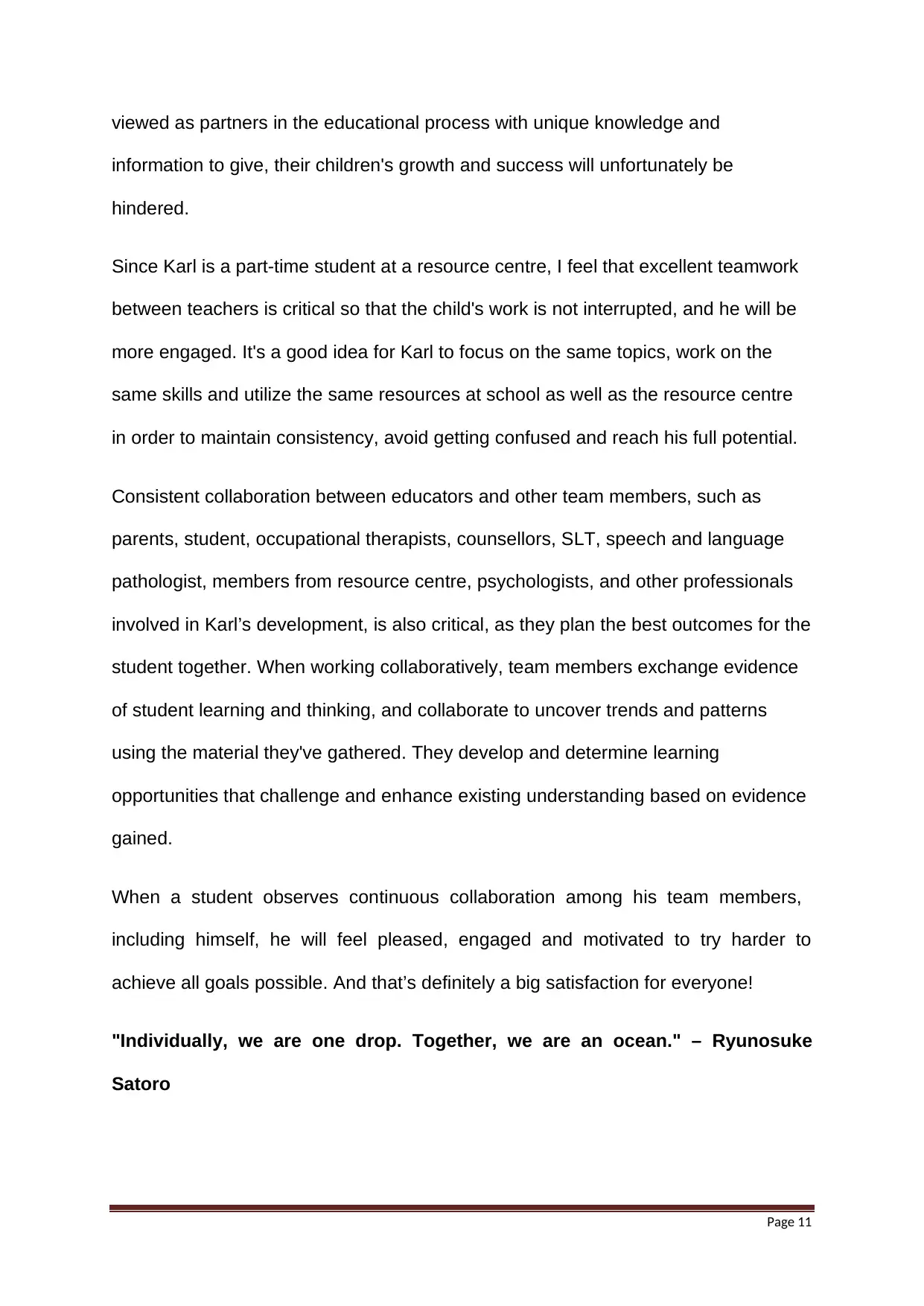
Page 11
viewed as partners in the educational process with unique knowledge and
information to give, their children's growth and success will unfortunately be
hindered.
Since Karl is a part-time student at a resource centre, I feel that excellent teamwork
between teachers is critical so that the child's work is not interrupted, and he will be
more engaged. It's a good idea for Karl to focus on the same topics, work on the
same skills and utilize the same resources at school as well as the resource centre
in order to maintain consistency, avoid getting confused and reach his full potential.
Consistent collaboration between educators and other team members, such as
parents, student, occupational therapists, counsellors, SLT, speech and language
pathologist, members from resource centre, psychologists, and other professionals
involved in Karl’s development, is also critical, as they plan the best outcomes for the
student together. When working collaboratively, team members exchange evidence
of student learning and thinking, and collaborate to uncover trends and patterns
using the material they've gathered. They develop and determine learning
opportunities that challenge and enhance existing understanding based on evidence
gained.
When a student observes continuous collaboration among his team members,
including himself, he will feel pleased, engaged and motivated to try harder to
achieve all goals possible. And that’s definitely a big satisfaction for everyone!
"Individually, we are one drop. Together, we are an ocean." – Ryunosuke
Satoro
viewed as partners in the educational process with unique knowledge and
information to give, their children's growth and success will unfortunately be
hindered.
Since Karl is a part-time student at a resource centre, I feel that excellent teamwork
between teachers is critical so that the child's work is not interrupted, and he will be
more engaged. It's a good idea for Karl to focus on the same topics, work on the
same skills and utilize the same resources at school as well as the resource centre
in order to maintain consistency, avoid getting confused and reach his full potential.
Consistent collaboration between educators and other team members, such as
parents, student, occupational therapists, counsellors, SLT, speech and language
pathologist, members from resource centre, psychologists, and other professionals
involved in Karl’s development, is also critical, as they plan the best outcomes for the
student together. When working collaboratively, team members exchange evidence
of student learning and thinking, and collaborate to uncover trends and patterns
using the material they've gathered. They develop and determine learning
opportunities that challenge and enhance existing understanding based on evidence
gained.
When a student observes continuous collaboration among his team members,
including himself, he will feel pleased, engaged and motivated to try harder to
achieve all goals possible. And that’s definitely a big satisfaction for everyone!
"Individually, we are one drop. Together, we are an ocean." – Ryunosuke
Satoro
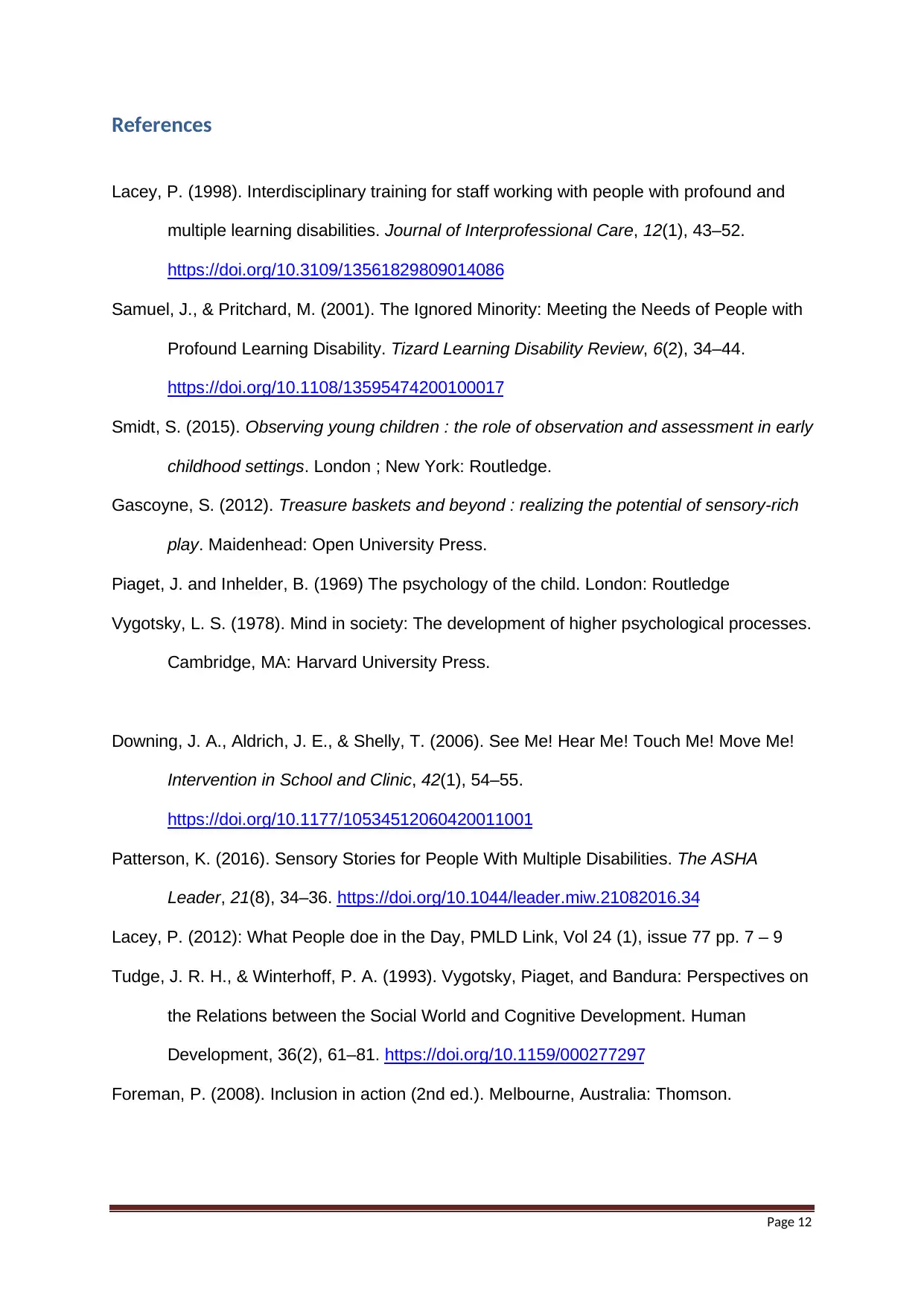
Page 12
References
Lacey, P. (1998). Interdisciplinary training for staff working with people with profound and
multiple learning disabilities. Journal of Interprofessional Care, 12(1), 43–52.
https://doi.org/10.3109/13561829809014086
Samuel, J., & Pritchard, M. (2001). The Ignored Minority: Meeting the Needs of People with
Profound Learning Disability. Tizard Learning Disability Review, 6(2), 34–44.
https://doi.org/10.1108/13595474200100017
Smidt, S. (2015). Observing young children : the role of observation and assessment in early
childhood settings. London ; New York: Routledge.
Gascoyne, S. (2012). Treasure baskets and beyond : realizing the potential of sensory-rich
play. Maidenhead: Open University Press.
Piaget, J. and Inhelder, B. (1969) The psychology of the child. London: Routledge
Vygotsky, L. S. (1978). Mind in society: The development of higher psychological processes.
Cambridge, MA: Harvard University Press.
Downing, J. A., Aldrich, J. E., & Shelly, T. (2006). See Me! Hear Me! Touch Me! Move Me!
Intervention in School and Clinic, 42(1), 54–55.
https://doi.org/10.1177/10534512060420011001
Patterson, K. (2016). Sensory Stories for People With Multiple Disabilities. The ASHA
Leader, 21(8), 34–36. https://doi.org/10.1044/leader.miw.21082016.34
Lacey, P. (2012): What People doe in the Day, PMLD Link, Vol 24 (1), issue 77 pp. 7 – 9
Tudge, J. R. H., & Winterhoff, P. A. (1993). Vygotsky, Piaget, and Bandura: Perspectives on
the Relations between the Social World and Cognitive Development. Human
Development, 36(2), 61–81. https://doi.org/10.1159/000277297
Foreman, P. (2008). Inclusion in action (2nd ed.). Melbourne, Australia: Thomson.
References
Lacey, P. (1998). Interdisciplinary training for staff working with people with profound and
multiple learning disabilities. Journal of Interprofessional Care, 12(1), 43–52.
https://doi.org/10.3109/13561829809014086
Samuel, J., & Pritchard, M. (2001). The Ignored Minority: Meeting the Needs of People with
Profound Learning Disability. Tizard Learning Disability Review, 6(2), 34–44.
https://doi.org/10.1108/13595474200100017
Smidt, S. (2015). Observing young children : the role of observation and assessment in early
childhood settings. London ; New York: Routledge.
Gascoyne, S. (2012). Treasure baskets and beyond : realizing the potential of sensory-rich
play. Maidenhead: Open University Press.
Piaget, J. and Inhelder, B. (1969) The psychology of the child. London: Routledge
Vygotsky, L. S. (1978). Mind in society: The development of higher psychological processes.
Cambridge, MA: Harvard University Press.
Downing, J. A., Aldrich, J. E., & Shelly, T. (2006). See Me! Hear Me! Touch Me! Move Me!
Intervention in School and Clinic, 42(1), 54–55.
https://doi.org/10.1177/10534512060420011001
Patterson, K. (2016). Sensory Stories for People With Multiple Disabilities. The ASHA
Leader, 21(8), 34–36. https://doi.org/10.1044/leader.miw.21082016.34
Lacey, P. (2012): What People doe in the Day, PMLD Link, Vol 24 (1), issue 77 pp. 7 – 9
Tudge, J. R. H., & Winterhoff, P. A. (1993). Vygotsky, Piaget, and Bandura: Perspectives on
the Relations between the Social World and Cognitive Development. Human
Development, 36(2), 61–81. https://doi.org/10.1159/000277297
Foreman, P. (2008). Inclusion in action (2nd ed.). Melbourne, Australia: Thomson.
⊘ This is a preview!⊘
Do you want full access?
Subscribe today to unlock all pages.

Trusted by 1+ million students worldwide
1 out of 14
Related Documents
Your All-in-One AI-Powered Toolkit for Academic Success.
+13062052269
info@desklib.com
Available 24*7 on WhatsApp / Email
![[object Object]](/_next/static/media/star-bottom.7253800d.svg)
Unlock your academic potential
Copyright © 2020–2025 A2Z Services. All Rights Reserved. Developed and managed by ZUCOL.





